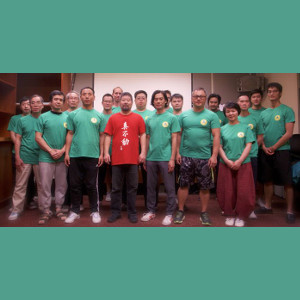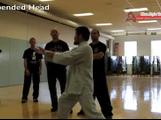
|
Master Chen’s SEA Tour 2017 was an informative and well attended event. This annual event was organized by Disciple Nicholas Fung (馮嘉傑) from the Hong Kong Practical Methods. Participants from the region and Canada attended three nights of intensive training on the theory and applications of the Practical Method of Chen Style Taijiquan. The lucky few also had private one-on-one training with Master Chen. A special thanks to guest instructors Pang Zhao Li (庞朝立; Rizhao City, Shandong Province; 山东省日照市) and Brenon Toh (Canada) for helping out during the seminar. The following is some of my notes and impressions of the seminar. |

|
Pang Zhao Li is currently the instructor at Rizhao City Chen Zhonghua Taiji Academy (日照陈中华太极馆). He had posted his impression of his travels to Hong Kong and his experience at the seminar here (in Chinese).
All participants had the pleasure of playing with Pang. To quote one participant about this experience ” .. is like I was caught in a washing machine. Whatever I did, I just got spun out!”. During the three nights, Master Chen explained the important theoretical considerations in the Practical Method system and then applied those theories to Foundation training, Form training leading to practical demonstrations of those theories. As always, from theory to practice, there should be no deviations. |
Traditional Chinese Martial Arts
Recently in Ottawa, Master Chen provided an introduction to the Practical Method to a Western audience. In Hong Kong, Master Chen provided another perspective based on an understanding of Chinese Martial Arts and its relationship to Taijiquan that is targeted towards a Chinese audience.
 Practical Method Chen Style Taijiquan (陈式太极拳实用拳法) is a Chinese Martial Art (武術). This is an important distinction because it affects our approach to learning and practicing this art. Chinese Martial Arts is also colloquially known as Kung Fu (功夫). It is a fighting art used for military combat or in “life or death” situations. In real application, any traditional Martial Art technique had to be lethal. However, during a time of peace, in order to train or learn this Art, theories were developed. During such training, lethal blows were deemed “illegal” and practitioner “pretend” to engage in combat according to implicit rules governing their behavior. In a previous lecture, Master Chen discuss the important factor of ethics that allows the limitations of theoretical training be applied as an actual combat technique. This is why the theory of Traditional Chinese Martial Arts is different from its applications. As human society evolved, the question of survival and self-preservation no longer dominates, so the non-lethal aspects of training became prevalent. As a result, the field of Traditional Chinese Martial Arts has changed. Taijiquan as a Martial Art also has changed. The Practical Method, however, acknowledges those societal changes but seek to preserve the root and origin of Taijiquan. The actual combat applications is always present but its ultimate use is up to the decision of the practitioner.
Practical Method Chen Style Taijiquan (陈式太极拳实用拳法) is a Chinese Martial Art (武術). This is an important distinction because it affects our approach to learning and practicing this art. Chinese Martial Arts is also colloquially known as Kung Fu (功夫). It is a fighting art used for military combat or in “life or death” situations. In real application, any traditional Martial Art technique had to be lethal. However, during a time of peace, in order to train or learn this Art, theories were developed. During such training, lethal blows were deemed “illegal” and practitioner “pretend” to engage in combat according to implicit rules governing their behavior. In a previous lecture, Master Chen discuss the important factor of ethics that allows the limitations of theoretical training be applied as an actual combat technique. This is why the theory of Traditional Chinese Martial Arts is different from its applications. As human society evolved, the question of survival and self-preservation no longer dominates, so the non-lethal aspects of training became prevalent. As a result, the field of Traditional Chinese Martial Arts has changed. Taijiquan as a Martial Art also has changed. The Practical Method, however, acknowledges those societal changes but seek to preserve the root and origin of Taijiquan. The actual combat applications is always present but its ultimate use is up to the decision of the practitioner.
All traditional Chinese Martial Arts have developed their own theory and method of training. The method (方法) of Taijiquan is “from the inside to the outside”. (内至外) . In contrast, many other systems is based on the opposite idea of “moving from the outside to reach the inside”. A concrete example to illustrate the Taiji method is to consider the action when a balloon is being inflated. The action is from the inside expanding out. So this method appears to be traditional but it is based on very scientific principles. A restriction (of the outside) can result in an increase in potential energy on the inside. The ability to execute such actions is very difficult because such actions are counter intuitive and cannot be carried out due to our day-to-day habits. So the chance of success is very remote. How difficult? Through the entire human history, members of the Chen village was able to develop this ability. The name of Taijiquan masters are still a handful. However, the situation is not bleak because there is clear system of learning.
Content of the Practical Method
The content (内容) of the method consists of the first form (一路), the second form (二路) and the straight sword (剑). Everything else, for example, stories of contests, additional exercises are myths and legends. They have not been transmitted directly or have been physically experienced. The importance of hands on transmission have been previously discussed. This is the emphasis of the “practical” over the imagined.
The problem in Taijiquan is how to carry out the general teaching process yet perform all the necessary actions based on the rule of “moving the inside then the outside.” The solution is the idea of “split” or “stretch”. ( As described previously in Ottawa), a stretch requires a fixed point and a moving point. In general, one point is always present and that is the dantian or the waist. So the art of Taiji is to learn how to use the dantian or the waist. From this one solution, the concepts of dots, lines, angles, speed and timing arises.
Distinguishing features
 A distinguishing feature of the Practical Method is that the Art is not based on velocity or momentum but rather all actions and its resultant effects are based on structure (结构). A structure is the result of movement and tranquility. The idea is to create physical structures with your body and your actions that satisfy the requirements of the principle of Taijiquan. There is no intention to differentiate which approach, that is either velocity based actions or structural based actions, is better. Since both approaches can accomplish the same task. It is sufficient to say that the training is to based on the structural approach. In this approach, speed is the time require to setup the structure in contrast to the normal consideration of speed which is the time require to cover a distance. In the Practical Method, we are training to create one particular structure – a triangle (三角形). A triangle can also be understood as an arch. In a physical triangle, the apex can support a load and its action can affect the base of the triangle. Consequently, the actions of a triangular structure satisfies the principle requirement of Taiji which is “from the inside (apex) to the outside (base)”.
A distinguishing feature of the Practical Method is that the Art is not based on velocity or momentum but rather all actions and its resultant effects are based on structure (结构). A structure is the result of movement and tranquility. The idea is to create physical structures with your body and your actions that satisfy the requirements of the principle of Taijiquan. There is no intention to differentiate which approach, that is either velocity based actions or structural based actions, is better. Since both approaches can accomplish the same task. It is sufficient to say that the training is to based on the structural approach. In this approach, speed is the time require to setup the structure in contrast to the normal consideration of speed which is the time require to cover a distance. In the Practical Method, we are training to create one particular structure – a triangle (三角形). A triangle can also be understood as an arch. In a physical triangle, the apex can support a load and its action can affect the base of the triangle. Consequently, the actions of a triangular structure satisfies the principle requirement of Taiji which is “from the inside (apex) to the outside (base)”.
A second distinguishing feature of the Practical Method is the use of indirect power (間接力). Indirect power can be understood in comparison to direct power. Direct power is the ability or capacity to act on a point without intervening factors or intermediaries. In contrast, in-direct power act on a point through one or more intermediaries such as joints. Indirect power creates structural power and this allows action on a point without change in direction, speed or force. Once again, there is no intention to compare the merits of direct versus indirect power since both types of power have their own value. However, using indirect power is a requirement if one is to train in the Practical Method. The objective in training is to use this principle of indirect power consistently.
The Last Jedi
 In one seminar, Master Chen noted that “things that are similar tend to appear in the same manner” so one can find that the same principle appearing in different areas. Master Chen cites two examples to illustrates this point. In the first example, he notes that many people who attends his seminars on the Practical Method makes the remark that Master Chen’s explanations are very scientific. Master Chen is always perplexed at those remarks because his formal training is based only on Taijiquan and his studies in Linguistics. His scientific training is rudimentary but yet many professional scientists and engineers recognize some core elements of Master Chen’s teachings as being based on sound scientific principles. In the second example, Master Chen once left some of his foreign students under the care and directions of one of his senior Taiji brothers , Master Chen was not familiar with this particular student of Hong but this senior has extensive teaching experience. Master Chen did not know the curriculum of this teacher so he asked his students to document their training with this elder when Master Chen was away. After a few weeks, Master Chen returned and asked his students about their notes. The students reply, they stopped taking notes after the first few days because the instructions were the same as Master Chen’s.
In one seminar, Master Chen noted that “things that are similar tend to appear in the same manner” so one can find that the same principle appearing in different areas. Master Chen cites two examples to illustrates this point. In the first example, he notes that many people who attends his seminars on the Practical Method makes the remark that Master Chen’s explanations are very scientific. Master Chen is always perplexed at those remarks because his formal training is based only on Taijiquan and his studies in Linguistics. His scientific training is rudimentary but yet many professional scientists and engineers recognize some core elements of Master Chen’s teachings as being based on sound scientific principles. In the second example, Master Chen once left some of his foreign students under the care and directions of one of his senior Taiji brothers , Master Chen was not familiar with this particular student of Hong but this senior has extensive teaching experience. Master Chen did not know the curriculum of this teacher so he asked his students to document their training with this elder when Master Chen was away. After a few weeks, Master Chen returned and asked his students about their notes. The students reply, they stopped taking notes after the first few days because the instructions were the same as Master Chen’s.
I found this explanation and examples to be valid based on my own experiences. During my workshop reviews, I have often use popular entertainment references to illustrate my understanding of Master Chen’s teachings. For example, I have referred to Kung Fu Panda, Mahler’s Fifth and Chinese poetry in previous reviews to convey the ideas of Taijiquan. On this occasion, after the workshop, the movie “The Last Jedi” came to mind.
So who said it? A Jedi (絕地武士) or Master Chen.:
- “Most of what we learn is useless but the process of learning must start somewhere … .”
- “The greatest teacher, failure is. .”
- “Impressive. Every word in that sentence was wrong. “
- “Balance and energy. A force.”
- “Use the mind and intention to establish the action.”
- “Train yourself to let go of everything you fear to lose.”
- “Smoothness is from accuracy. Smoothness is not a quality but movement without deviations.”
- “Good things has similarities.”
- “You must unlearn what you have learned.”
- “Many of the truths that we cling to depend on our point of view.”
- “One technique can solve all problems.”
- “.. uses … for knowledge and defense, never for attack.”
- “Size matters not. Look at me. Judge me by my size, do you? ”
- “Always two there are, no more, no less.”
It’s funny how things work out that way. I remember another story. A senior student once remarked to Master Chen that after training in the Practical Method, the student is seeing lines and dots everywhere! Now, I seem to hear Master Chen everywhere. Weird.
Finally …
| 新年快乐 | ||
| 萬 |

|
一 |
| 事 | 颿 | |
| 如 | 風 | |
| 意 | 顺 | |
| 步 | 年 | |
| 步 | 年 | |
| 高 | 好 | |
| Happy New Year | ||
The poem roughly translates as: wishing everyone: “Smooth sailing with each year; success with each step. “




{ 1 comment… read it below or add one }
Thanks, Ming! Awesome summary as always! Happy New Year!